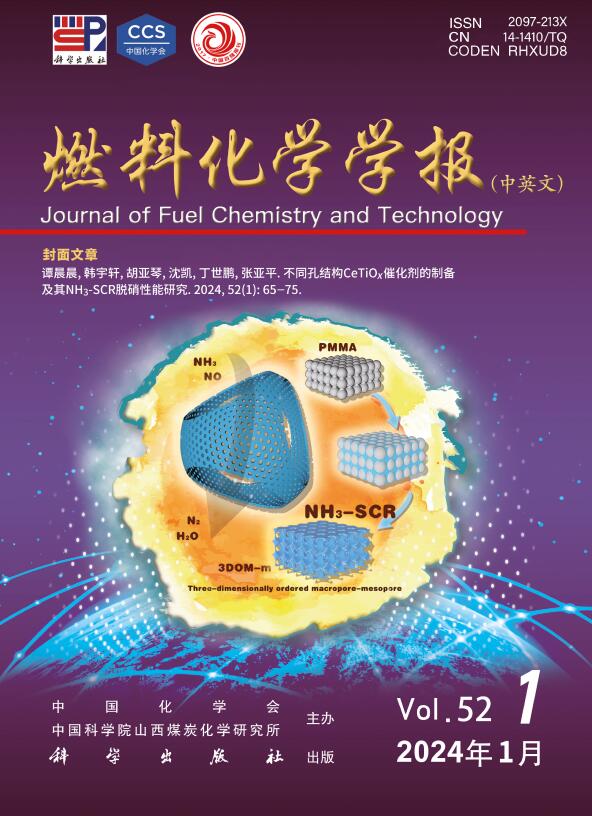Low temperature hydrocracking of 9,10-dihydrophenanthrene over Brønsted acidic zeolite Y
Q3 Energy
引用次数: 0
Abstract
Facing the escalating challenge of processing heavier and lower-quality crude oils, the utilization of light cycle oil (LCO) derived from fluid catalytic cracking units is constrained by its high aromatic content. The transformation of LCO into lighter aromatic hydrocarbons through catalytic conversion emerges as a more advantageous and valuable strategy, addressing the surplus of diesel and the scarcity of light aromatics. Consequently, the hydroconversion of 9,10-dihydrophenanthrene (9,10-DHP), serving as a representative molecule of polycyclic aromatic hydrocarbons (PAHs), over metal-free zeolite Y catalysts with varying acidity, has been investigated in a stirred batch reactor. The experiments were conducted at temperatures ranging from 250 to 350 ℃ under a pressure of 4.0 MPa. The study delved into the impact of reaction temperature and the Brønsted acidity of zeolite Y on the reaction pathway. Product analysis revealed the formation of a diverse array of products, including biphenyls, naphthalenes, tetralins, indanes, alkylbenzenes, benzene, and minor alkanes, during the hydrocracking of 9,10-DHP. The reaction pathway for the hydrocracking of 9,10-DHP to monocyclic aromatic hydrocarbons (MAHs) over acidic zeolite Y was proposed to follow two potential routes: one involving hydrogen transfer leading to the formation of phenanthrene and tetrahydrophenanthrene, followed by terminal ring opening; the other characterized by a direct central ring opening. The interplay between these two pathways is contingent upon the reaction temperature and the acidity of the employed zeolite. Promoting central ring opening and suppressing hydrogen transfer can be realized by manipulating the reaction temperature and enhancing the acid density of the zeolite. However, excessive hydrogenation and cracking are observed with further increases in reaction temperature. Additionally, augmenting the strength of acidic sites is beneficial for ring opening and isomerization of hydrogenated aromatics, as well as dealkylation to produce MAHs. The findings underscore a promising approach for the design of PAHs hydrocracking catalysts and reaction techniques.
9,10-二氢菲在Brønsted酸性沸石Y上的低温加氢裂化
面对日益严峻的重质、低品质原油加工挑战,轻循环油(LCO)的高芳烃含量限制了其利用。通过催化转化将LCO转化为更轻的芳烃是一种更有利和更有价值的策略,可以解决柴油过剩和轻芳烃短缺的问题。因此,作为多环芳烃(PAHs)的代表分子,9,10-二氢菲(9,10- dhp)在不同酸度的无金属沸石Y催化剂上的加氢转化,已经在搅拌间歇式反应器中进行了研究。实验温度为250 ~ 350℃,压力为4.0 MPa。研究了反应温度和Y沸石的Brønsted酸度对反应途径的影响。产物分析表明,在9,10- dhp加氢裂化过程中,形成了多种产物,包括联苯、萘、四苯、茚、烷基苯、苯和小烷烃。9,10- dhp在酸性Y沸石上加氢裂化生成单环芳烃(MAHs)的反应途径有两种:一种是氢转移生成菲和四氢菲,然后端开环;另一种以直接的中心环开口为特征。这两种途径之间的相互作用取决于反应温度和所用沸石的酸度。通过调节反应温度,提高沸石的酸密度,可以促进中心环打开,抑制氢转移。然而,随着反应温度的进一步升高,会出现过度的加氢和裂化现象。此外,增加酸性位点的强度有利于氢化芳烃的开环和异构化,以及脱烷基反应生成mah。这一发现为设计多环芳烃加氢裂化催化剂和反应技术提供了一条有前途的途径。
本文章由计算机程序翻译,如有差异,请以英文原文为准。
求助全文
约1分钟内获得全文
求助全文
来源期刊

燃料化学学报
Chemical Engineering-Chemical Engineering (all)
CiteScore
2.80
自引率
0.00%
发文量
5825
期刊介绍:
Journal of Fuel Chemistry and Technology (Ranliao Huaxue Xuebao) is a Chinese Academy of Sciences(CAS) journal started in 1956, sponsored by the Chinese Chemical Society and the Institute of Coal Chemistry, Chinese Academy of Sciences(CAS). The journal is published bimonthly by Science Press in China and widely distributed in about 20 countries. Journal of Fuel Chemistry and Technology publishes reports of both basic and applied research in the chemistry and chemical engineering of many energy sources, including that involved in the nature, processing and utilization of coal, petroleum, oil shale, natural gas, biomass and synfuels, as well as related subjects of increasing interest such as C1 chemistry, pollutions control and new catalytic materials. Types of publications include original research articles, short communications, research notes and reviews. Both domestic and international contributors are welcome. Manuscripts written in Chinese or English will be accepted. Additional English titles, abstracts and key words should be included in Chinese manuscripts. All manuscripts are subject to critical review by the editorial committee, which is composed of about 10 foreign and 50 Chinese experts in fuel science. Journal of Fuel Chemistry and Technology has been a source of primary research work in fuel chemistry as a Chinese core scientific periodical.
 求助内容:
求助内容: 应助结果提醒方式:
应助结果提醒方式:


